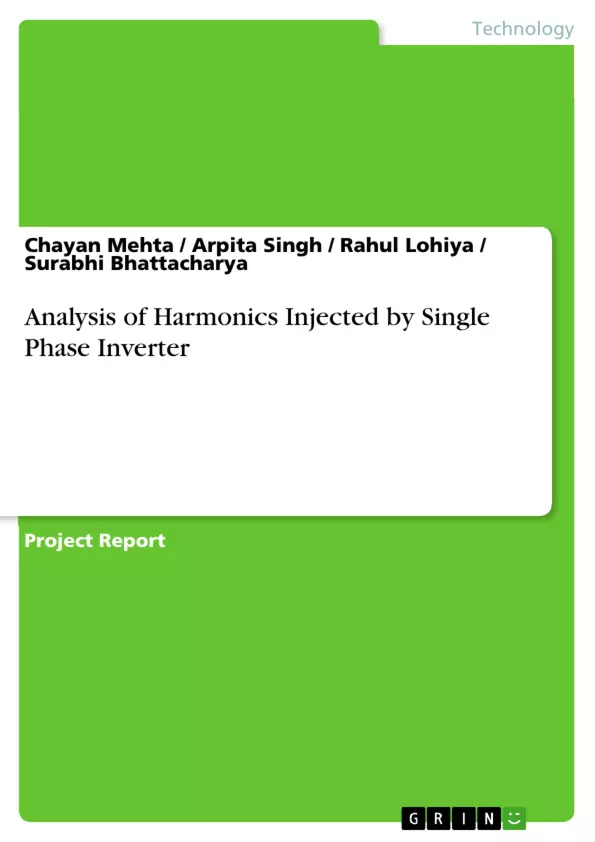The power electronics device which converts DC power to AC power at required output voltage and frequency level is known as inverter. As we have found that different inverters are used for different equipment’s so in our project titled “ Analysis of Harmonics injected by Single phase Inverter” , we are analyzing the harmonics present in single phase voltage source inverter using different loads (R,RL and RLC).
We are analyzing Harmonics using MATLAB tools like Scope for harmonics and Simulink powergui for analysis of FFT of different Signals.
Table of Contents
- Chapter 1 Introduction
- Software Used
- Single Phase Voltage Inverter
- Single Phase Half Bridge Inverter
- Single Phase Full Bridge Inverter
- Chapter 2 Analysis of Single Phase Inverter
- Analysis of Single Phase Half Bridge Inverter with R load
- Single Phase Inverter Half Bridge with RL load
- Single Phase Inverter Half Bridge with RLC Load
- Analysis of Single Phase Full- Wave Inverter with R load
- Single Phase Inverter Half Wave with RL load
- Single Phase Inverter Half Wave with RLC load
- Chapter 3 Results
- FFT Analysis of Single Phase Half Bridge Inverter with R load
- Single Phase Inverter Half Bridge with RL load
- Single Phase Inverter Half Bridge with RLC Load
- FFT Analysis of Single Phase Full- Wave Inverter with R load
- Single Phase Inverter Half Wave with RL load
- Single Phase Inverter Half Wave with RLC load
- Chapter 4 Conclusion
- Chapter 5 Further Scope
Objectives and Key Themes
This minor project report analyzes the harmonics injected by a single-phase inverter under various load conditions (R, RL, and RLC). The main objective is to investigate and characterize the harmonic content in the output waveform of both half-bridge and full-bridge single-phase inverters using MATLAB Simulink. The project aims to provide a comprehensive understanding of harmonic generation in these inverters, which is crucial for ensuring efficient and reliable operation.
- Harmonic analysis of single-phase inverters.
- Impact of different load types (R, RL, RLC) on harmonic generation.
- Comparison of half-bridge and full-bridge inverter performance.
- Utilization of MATLAB Simulink for simulation and analysis.
- Evaluation of harmonic content and its implications for power quality.
Chapter Summaries
Chapter 1 Introduction: This chapter introduces the concept of inverters, their applications (adjustable-speed AC drives, induction heating, etc.), and different types (voltage source and current source inverters). It also defines harmonics and their significance in power systems. The chapter describes the software (MATLAB R2010a) and tools (MATLAB Simulink) used for the analysis. Finally, it introduces single-phase half-bridge and full-bridge inverters with circuit diagrams.
Chapter 2 Analysis of Single-phase Bridge Inverters: This chapter presents a detailed analysis of both half-bridge and full-bridge single-phase inverters under resistive (R), resistive-inductive (RL), and resistive-inductive-capacitive (RLC) load conditions. For each configuration, the chapter provides circuit diagrams, explains the simulation setup in MATLAB Simulink, and shows the obtained waveforms of output voltage and current. It highlights the differences in the waveforms' shapes and harmonic content under various load conditions.
Chapter 3 Results: This chapter presents the Fast Fourier Transform (FFT) analysis of the output waveforms obtained in Chapter 2. For each inverter configuration (half-bridge and full-bridge with R, RL, and RLC loads), the chapter displays the FFT plots, visualizing the harmonic components present in the output voltage and current waveforms. The analysis allows for a quantitative assessment of the harmonic content and comparison between different load types and inverter topologies.
Keywords
Single-phase inverter, harmonics, FFT analysis, MATLAB Simulink, half-bridge inverter, full-bridge inverter, resistive load, inductive load, capacitive load, power quality, IGBTs.
Frequently Asked Questions: Single-Phase Inverter Harmonic Analysis
What is the main topic of this document?
This document is a comprehensive report analyzing the harmonic content generated by single-phase half-bridge and full-bridge inverters under various load conditions (resistive (R), resistive-inductive (RL), and resistive-inductive-capacitive (RLC)). The analysis uses MATLAB Simulink for simulation and includes detailed chapter summaries, objectives, and keywords.
What software was used for the analysis?
MATLAB R2010a and its Simulink toolbox were used for the simulation and analysis of the single-phase inverters.
What types of inverters are analyzed?
The report analyzes both single-phase half-bridge and full-bridge inverters.
What load conditions were considered?
The inverters were analyzed under three load conditions: purely resistive (R), resistive-inductive (RL), and resistive-inductive-capacitive (RLC).
What is the main objective of the analysis?
The main objective is to investigate and characterize the harmonic content in the output waveform of both half-bridge and full-bridge single-phase inverters under different load conditions. This helps understand harmonic generation and its impact on efficient and reliable operation.
What key themes are addressed?
Key themes include harmonic analysis of single-phase inverters, the impact of different load types on harmonic generation, a comparison of half-bridge and full-bridge inverter performance, the use of MATLAB Simulink for simulation and analysis, and the evaluation of harmonic content and its implications for power quality.
What are the key chapters and their contents?
Chapter 1 (Introduction): Introduces inverters, their applications, types, harmonics, and the software used. Presents circuit diagrams of half-bridge and full-bridge inverters.
Chapter 2 (Analysis of Single-phase Bridge Inverters): Provides a detailed analysis of both inverter types under R, RL, and RLC loads, including circuit diagrams, simulation setups, and waveforms.
Chapter 3 (Results): Presents FFT analysis of the output waveforms from Chapter 2, showing harmonic components for each configuration.
Chapter 4 (Conclusion): Summarizes the findings.
Chapter 5 (Further Scope): Suggests potential future research directions.
What type of analysis was performed to quantify the harmonics?
Fast Fourier Transform (FFT) analysis was used to quantify the harmonic content in the output voltage and current waveforms.
What are the key keywords associated with this report?
Single-phase inverter, harmonics, FFT analysis, MATLAB Simulink, half-bridge inverter, full-bridge inverter, resistive load, inductive load, capacitive load, power quality, IGBTs.
- Arbeit zitieren
- Chayan Mehta (Autor:in), Arpita Singh (Autor:in), Rahul Lohiya (Autor:in), Surabhi Bhattacharya (Autor:in), 2013, Analysis of Harmonics Injected by Single Phase Inverter, München, GRIN Verlag, https://www.grin.com/document/265312



